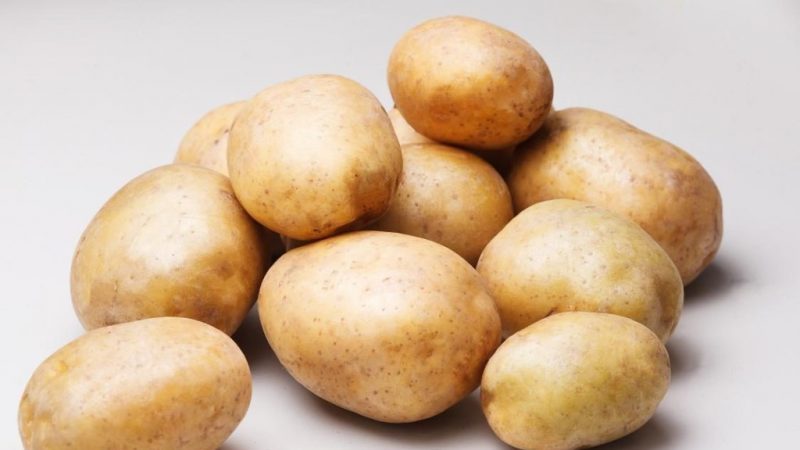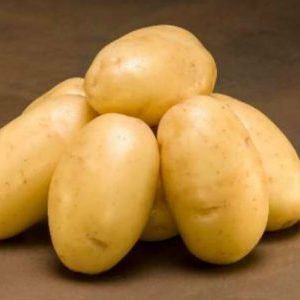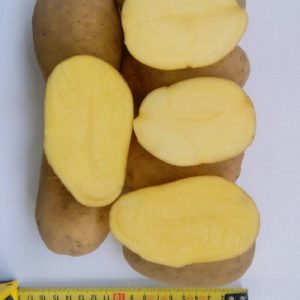Medium late table potato "Ragneda" adaptable to any soil
Potato varieties differ not only in yield and ripening times, but also in their ability to adapt to different types of soil. There are varieties that can be grown in all regions of Russia. One of them is Ragneda.
The content of the article
Description of the variety
The mid-late Ragneda variety has appeared recently, and has already become popular among gardeners. Growing such potatoes requires more work than cultivating early varieties, but the taste and keeping quality of the crop are worth the effort.

Origin and development
The variety was bred by breeders of the Scientific and Production Center of the National Academy of Sciences of Belarus for Potato and Fruit and Vegetable Growing. Produced by crossing the Sorcerer variety and form 1579-14.
Reference. In 2011, the Ragneda variety was registered in the State Register of Russia.
Chemical composition, trace elements and vitamins
Potatoes contain proteins, vitamins and mineral salts. Vitamin C is enough to fill its daily requirement if potatoes are consumed 200-300 g per day.
The tubers contain a complex of B vitamins, folic acid, potassium and phosphorus salts, organic acids - citric, oxalic and malic.
Attention! The peel of potato tubers and its aerial part contains a poisonous substance - solanine. It is especially abundant in sprouted tubers. Do not eat green tubers - this is a sign of a high concentration of solanine.
Ripening period
Ragneda potatoes are a medium late variety with a ripening period of 95 to 110 days from the moment the first shoots appear. This time is enough for the tubers to ripen well.
The harvest begins 30-40 days after the end of flowering, when the tops turn yellow and dry out. One to two weeks before harvesting, the aboveground part is mowed. This is necessary for the tubers to be better stored.
Disease resistance
Ragneda is resistant to most common diseases. The variety is moderately resistant to late blight and leaf-rolling virus. Copes well with potato cancer, Alternaria, golden cyst nematode.
Important! Another advantage of the variety is resistance to mechanical damage. This allows you to transport crops over long distances without loss.
Characteristics of tubers and description of the bush

Ragneda forms a tall shrub with several stems reaching 85 cm. The stems are thick, upright, light green in color.
The leaf plate is rounded, tapering towards the top. The surface of the leaf is corrugated, with a slight edge and convex veins.
Flowers are white, panicle-shaped inflorescences.
Characteristics of Ragneda potatoes:
- tubers are rounded, elongated in the form of an oval, yellow peel;
- the mass of a ripe tuber is 70-120 g;
- Ragneda potatoes contain 17.5% starch, therefore, when cooked, they become moderately crumbly and retain their integrity;
- the peel is thin, strong, with few small eyes;
- the pulp is dense, creamy;
- after cleaning and does not darken at the cut site.
The average yield is 187-353 kg / ha. Under favorable conditions for growth and development, you can get up to 430 kg / ha, from one bush - 15-20 pcs. This feature should be taken into account when planting potatoes and planting tubers at a greater distance than usual.
Growing regions
The variety is recommended for cultivation in the North-West region: Vologda, Kaliningrad, Leningrad, Novgorod, Pskov regions, the Republic of Karelia.
Its unpretentiousness allows you to harvest in different regions of Russia, Ukraine, Belarus.
Advantages and disadvantages of the variety
Benefits of Ragneda Potatoes:
- adapted to the temperate climate zone;
- frost-resistant;

- with minor damage, replaces the affected shoots with new ones;
- can do without watering for a long time;
- medium sized tubers suitable for mechanized harvesting;
- high productivity;
- immunity to many common potato diseases;
- stored for 8-9 months;
- keeping quality of tubers is 97%.
The disadvantage of the culture is that under adverse weather conditions, the formation of small tubers with watery pulp is possible.
What is the difference from other varieties
If we compare Ragneda with other mid-late varieties, it is in the lead in many respects: it is unpretentious in care, resistant to many common potato diseases, and does not lose its taste for a long time.
Features of planting and growing
The Ragneda variety, when cultivated, requires compliance with certain rules.
Preparing for landing
3-4 weeks before planting, the seed is sorted and examined. Sick, small and weak tubers are discarded. Then the potatoes are laid out in the light for germination.
Ground requirements
Most types of soils in temperate climates are suitable for planting Ragneda potatoes. Light, crumbly soil is preferred. Heavy loamy soils are undesirable for planting. The plot should be well lit: tubers in beds with insufficient lighting will be smaller.
In the spring, the soil is dug up with the addition of manure. When choosing a site for potatoes, they use the rules of crop rotation: good yields can be achieved when planting in beds where cereals, alfalfa, clover, legumes, cabbage or pumpkin were previously sown.
Important! Do not use areas where tomatoes were growing for planting potatoes. Common pests and pathogens remain in the soil.
Timing, scheme and landing rules
Seed material is planted in early - mid-May, depending on weather conditions. Soil temperature should be at the level of 8-10 ° C.
Ragneda bushes are spreading, so the distance between the tubers must be kept up to 35 cm. The rows are placed at a distance of 70-90 cm. The depth of the hole is 15-17 cm. The planting material is sprinkled on top with peat, and then earth.
Growing features
When growing the Ragneda variety, standard agricultural techniques are used. For high yields, potatoes are fed 2 times per season.
Important! Avoid excess moisture in the area where potatoes grow. From this, the tops will lose elasticity and will break easily, which will lead to a decrease in yield. Do not plant in swampy, flooded areas.
Potatoes are a thermophilic plant. The optimum temperature for tuber formation is + 15 ... + 22 ° С.
Watering mode
Ragneda is a drought-resistant variety, therefore it does not require frequent watering. Water it on hot days twice a week. When buds appear and during flowering, they are watered more often. If the weather is rainy, no irrigation is carried out.

Top dressing
The Ragneda variety will grow and form tubers without feeding, but in order to get a good harvest, it is necessary to apply mineral fertilizers twice a season: "Nitrofoska", ammonium nitrate.
The first feeding is done when the bushes are medium in size, the second - a month after the first.
Weeding and hilling
Two weeks after planting, the first shoots appear, but the weeds will come out already on the 4th-5th day. At this point, you need to loosen the soil with a rake in order to remove the emerging weeds without harming the tubers.
They spud Ragneda three times:
- when the sprouts reach 8-12 cm;
- at the moment of closing the bushes;
- two weeks after the second hilling.
Hilling promotes the formation of additional roots, conserves moisture in the soil, and reduces the number of weeds.
Disease and pest control
Ragneda is resistant to many diseases, but there are a number of viruses that infect this variety:
- Virus Y. Aphids are transferred to hot dry summers. It is manifested by the withering away of the entire bush along with the root system.
- Rhizoctonia. Fungal infection occurs at low temperatures and high humidity. It is determined by black spots on the leaves and the bottom of the tops. In the fight against the disease, "Planriz" is used.
Insects that can harm potatoes:
- Colorado beetle... To combat it, use "Arrivo" and "Confidor".
- Wireworm... As a preventive measure, the soil is loosened and weeds are removed in a timely manner.
- Aphids and bears are destroyed with the help of chemical agents "Boverin" and "Medvetox".
Growing difficulties
Too moist, heavy soils can lead to rotting tubers. Climatic conditions in Russia are not always favorable for potato cultivation - prolonged rainstorms or droughts are possible.
Harvesting and storage
In order for the grown crop to please for a long time, it is important to harvest it correctly and on time.
How and when to collect
The technical maturity of tubers occurs at 95-110 days. The tops begin to turn yellow and dry. This period falls in mid-September. The tops are pre-mowed.
When cleaning avoid mechanical damage to tubers. Potatoes harvested from the garden are dried and sorted.
Storage features and keeping quality of the variety
Harvested crop keep in a dark place at a temperature not higher than + 5 ° С and air humidity 80%. Subject to storage conditions potatoes retains quality until May.
Tips from experienced gardeners

Experienced gardeners when growing Ragneda potatoes recommend:
- choose a sunny, unshaded area;
- dig up the soil before autumn with the addition of compost and wood ash;
- germinate tubers a week or two before planting;
- do not allow excess moisture in the beds.
Reviews
Reviews about this variety are most often positive, gardeners recommend it for cultivation.
Mikhail, Sortavala: «For many years I have been growing potatoes in my summer cottage. Including varieties of Ragneda. But there is one sore that no variety spares. This is late blight. It is known that it will not be present on soils rich in copper. This is how I fight late blight: before planting, I process the tubers with copper sulfate. And when the tops appear, I spray it too. "
Vasily, Vologda: "When, on the advice of a friend, I tried to grow Ragneda, I was pleasantly surprised: the variety is resistant to our weather conditions and pests, gives a decent harvest. I would recommend it even to novice gardeners. "
Marina, Lodeinoe Pole: “I found a description of the variety and a photo of Ragneda potatoes on the Internet, started growing 4 years ago. The variety is high-yielding, I take about 2.5 kg from one bush. It has other virtues as well. First of all, taste. The tubers are well preserved in the cellar until almost the next harvest. "
Conclusion
The Ragneda variety has established itself as a high-yielding, disease-resistant variety, and most importantly, capable of adapting to various types of soil. Varietal characteristics allow it to be grown not only for home use, but also for sale.